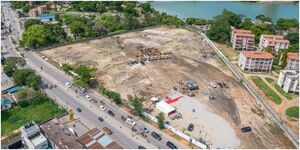The Kenya National Highways Authority (KeNHA) has announced that it will map out alternative routes for motorists who may wish to avoid paying toll charges along the Rironi–Nakuru–Mau Summit Highway once construction begins.
According to KeNHA, the routes will be identified where feasible for public consideration and use.
The authority in an announcement issued on Wednesday by Acting Director General Luka Kimeli, however, maintained that using the toll road will be cheaper overall due to reduced travel time, lower vehicle operating costs, and improved safety.
This comes following concerns raised by stakeholders, among them the Motorists Association of Kenya, who have criticised plans to toll the entire road stretches without alternative non-toll routes. The association also opposed the handover to foreign entities.
The highway project, which covers 175 kilometres of the A8 Road (Rironi–Nakuru–Mau Summit) and 58 kilometres of the A8 South Road (Rironi–Maai Mahiu–Naivasha), will improve connectivity between Nairobi, Central Kenya, the Rift Valley, and Western Kenya, according to KeNHA.
Construction Proposals
The government intends to implement the project under a PPP tolling model, allowing users to pay regulated toll fees to recover maintenance and investment costs. However, there have been a lot of controversies on the tendering process.
In response to this, KeNHA confirmed that three private firms initially submitted proposals for the project’s design, construction, financing, and operation: Shandong Hi-Speed Road and Bridge International Engineering Company Limited (SDRBI), China Road and Bridge Corporation (CRBC) in partnership with the National Social Security Fund (NSSF), and Multiplex Partners Company Limited from Burundi.
However, the authority has disclosed that the Burundian firm, Multiplex Partners, was dismissed after failing to comply with submission requirements, including payment of the mandatory proposal review fee.
The remaining two proposals, from CRBC and SDRBI, were evaluated and subjected to feasibility studies. Following the review, the PPP Committee under the National Treasury granted conditional approval for the two firms to proceed to the Project Development Phase (PDP).
CRBC and NSSF Greenlight
Following evaluations, the PPP Committee concurred that the consortium comprising CRBC and NSSF be designated as the preferred proponent. However, KeNHA clarified that the PPP Committee has not yet approved the project’s implementation, as negotiations are still ongoing.
“The PPP Committee has only allowed us to commence negotiations with the preferred proponent, and the process is currently ongoing,” KeNHA stated.
Once concluded, the project will include modern dual carriageways, service lanes, and tolling infrastructure designed to enhance safety, mobility, and trade efficiency along the corridor.
KeNHA assured the public that updates on the project’s progress and final agreements will be disclosed transparently in accordance with the PPP Act and National Treasury guidelines.












